The 2017 Tax Cuts and Jobs Act (TCJA) was the most consequential tax legislation signed into law since the 1980s. However, to comply with the budget reconciliation process used to create the law, many of the TCJA’s provisions were made temporary. The law’s future is uncertain, with most of the expiring provisions scheduled to sunset after December 31, 2025. The new Congress and President Donald Trump will decide the fate of each expiring provision.
The 2017 reforms were the product of countless hours of work and analysis to identify and resolve major problems that existed in the tax code. The outcome of the TCJA was mostly positive, but the package did include some less-than-ideal compromises.
The incoming Congress faces a similarly difficult task and a highly uncertain outcome as it decides how Americans will be taxed in 2026 and beyond. Navigating the tax extensions will be more difficult because of Congress’s runaway federal spending since the COVID-19 pandemic. That reckless spending has driven up the national debt by $13 trillion since January 2020 and stoked the higher inflation and interest rates that have been a major burden on families and businesses.REF
America’s economic prospects depend on how Congress handles the expiring tax provisions. If the expiring provisions lapse, Americans would face more than $4 trillion in net tax hikes over 10 years, according to government scorekeepers.REF Individuals would face higher tax rates and more complicated tax returns, and businesses would face tax rules that discourage investment. However, Congress must carefully weigh the trade-offs it faces as it considers each expiring TCJA provision.
This report is intended to equip policymakers with essential knowledge of the U.S. tax system and the TCJA to help them navigate the tax debate. The report begins with an overview of the U.S. tax system, including a summary of the sources of federal revenues. Readers who are already familiar with how the tax system functions may wish to skip to the section titled “What Happens If the Tax Cuts and Jobs Act Expires?,” which details the 15 key tax hikes (or in some cases, tax cuts) that would occur if the TCJA were to expire, including:
- General individual income tax provisions (changes to rates, standard deduction, personal exemption, and child tax credit);
- Alternative or overlapping taxes (changes to the alternative minimum tax and estate and gift taxes);
- Individual itemized tax deductions (changes to the state and local tax (SALT) deduction, mortgage interest deduction, other itemized deductions, and the Pease limitation);
- Business-related tax deductions (changes to the pass-through deduction, expensing for machinery and equipment, amortization of research and experimental expenditures, and business-loss limitations); and
- Other changes (opportunity zones and international provisions).
Finally, this Special Report describes the current state of America’s finances and concludes with some general recommendations for policymakers navigating the tax extension debate.REF
Overview of the Federal Tax System
This section provides an overview of the federal tax system, including a summary of the major sources of federal revenue and the structure of the current tax system.
Sources of Federal Revenue. Since the late 1940s, about 50 percent of federal revenues has consistently come from individual income taxes.REF Individual income tax collections as a share of the economy have been steady or slightly rising for most of the past 75 years despite Congress cutting the top individual income tax rate from over 90 percent during and after World War II to as low as 28 percent in 1988.REF (Today, the top individual income tax rate is 37 percent.REF)
Payroll tax revenues increased sharply as a share of federal revenues from the 1940s until the 1980s before stabilizing around 35 percent of federal revenues.REF
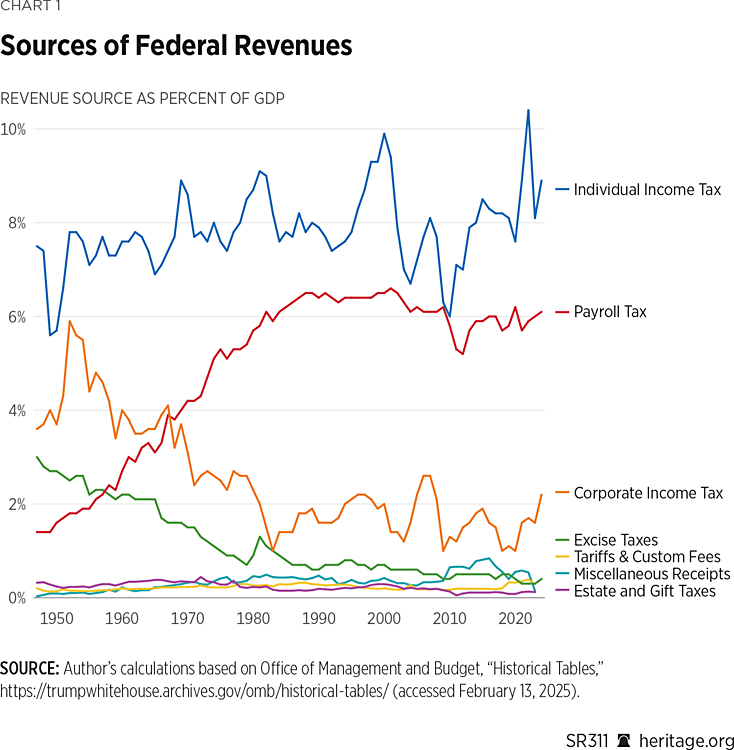
Corporate income tax revenues accounted for about 9 percent of federal receipts in 2023.REF The share of overall revenues from corporate taxes was higher before the 1980s, as most business income then was reported on corporate tax returns. Today, most business income is reported on individual income tax returns by pass-through business owners and sole proprietors. The reduction of individual income tax rates in the 1960s and 1980s incentivized business owners to transition away from a corporate tax structure where possible.REF As a result, the percentage of U.S. business net income earned by corporations fell from 75 percent to 37 percent between 1980 and 2015 (the latest year with reported data).REF
Federal revenues from other sources accounted for only about 5 percent of federal revenue in 2023. Excise taxes and tariffs account for about 2 percent of federal revenues each. Estate and gift taxes account for less than 1 percent of federal revenues.REF
General Structure of the U.S. Tax System. The U.S. income tax system imposes taxes on most types of income, from wages to royalties to capital gains to business income. It applies to individual workers, retirees, small business owners, corporations, investors, and trusts, though it applies differently to different types of entities and income in different situations.REF Although it is impossible to fully describe the income tax system in a short summary, this section encapsulates the general structure with a few key concepts:
- Types of tax filings and forms;
- Filing status;
- Tax base;
- Types of income;
- Tax brackets;
- Gross income, adjusted gross income, and taxable income;
- Tax credits, deductions, exclusions, and exemptions;
- Estate and gift taxes; and
- Other features of the tax system.
Types of Tax Filings and Forms. The federal income tax applies differently to individuals and various business types. When differences are significant, the Internal Revenue Service (IRS) requires taxpayers to report income on distinct tax forms. Key tax forms include Form 1040 (for individuals), Form 1041 (for trusts and estates), Form 1065 (for partnerships), Form 1120 (for C corporations), Form 1120-S (for S corporations), and Form 990 (for tax-exempt nonprofits).REF
Many individuals report business income on their individual returns. Self-employed individuals who act as sole proprietors report the details of their business profits and losses on a supplemental form (Schedule C).REF Partnerships file Form 1065, which determines their combined business income, deductions, and other tax items. However, instead of paying taxes at the business level, partnerships allocate gross income and deductions among the partners, effectively passing the profits or losses through to them to be taxed individually. Certain U.S. businesses with fewer than 100 shareholders and no more than one class of stock may elect to file as S corporations, which also pass profits and losses through to the individual shareholders.REF Partnerships and S corporations are referred to as pass-through entities.
C corporations (usually referred to simply as corporations) pay taxes directly at the corporate level.REF Unlike owners and investors in pass-through entities, investors in corporations directly pay taxes only when they receive their shares of business profits (e.g., dividends) from the corporations. However, the corporate profits that result in dividends are taxed both at the corporate level and then a second time through the individual tax imposed on the shareholders—that is, double taxation.
Filing Status. Taxpayers filing their individual income taxes using Form 1040 must select the appropriate filing status. The key filing statuses are single, married filing jointly, head of household, and married filing separately. Various features of the tax system adjust based on filing status. Because families have more material needs than single taxpayers do, brackets, exemptions, and credits are sometimes more generous for filing statuses that imply more people in the household (e.g., married filing jointly versus single). The tax code also includes a filing status for qualifying widow(ers) with dependent children that aligns with the married filing jointly status.REF
The head of household filing status is used by unmarried (including legally separated) individuals who pay at least half the costs of a home with qualifying children or dependents.REF The head of household filing status is more favorable than the single filing status.REF
Married couples can elect to file jointly or separately (though not as single). Married filing separately is uncommon, as it generally results in a higher combined tax liability compared to filing jointly (or even compared to the tax liability of two single filers).REF Married filing jointly is typically the most advantageous filing status for two adults sharing a home who have no children.REF
Tax Base. The tax base is a fundamental concept in tax policy. In the most basic terms, it is simply what is being taxed. For the income tax, the tax base is taxable income.REF The federal income tax’s definition of taxable income is complicated, because there are different perspectives about what constitutes income and what should be subject to taxation. As a result, the federal tax code fails to follow a consistent logic regarding what is included or excluded from the tax base. A large amount of income goes untaxed, while other income is subject to multiple layers of taxation.REF
In theory, the tax rate multiplied by the value of the tax base determines the amount of taxes that the government can collect. For the U.S. federal income tax, it is not that simple. Different buckets of income are taxed according to different tax rates, brackets, and exemption rules. The federal income tax base is, in a sense, the aggregation of several smaller, overlapping tax bases, including (but not limited to) ordinary income, long-term capital gains income, corporate income, and Subpart F income.REF
Base broadening involves eliminating or reducing carveouts such as tax credits, exclusions, exemptions, and deductions. For example, the TCJA broadened the tax base by limiting individuals to no more than a $10,000 deduction for state and local taxes, eliminating most other individual itemized deductions, and setting limits on the deductibility of business meal and entertainment expenses. The additional tax revenue from these changes facilitated lower tax rates for individuals and businesses.
A broad tax base with low tax rates is generally preferable to a narrow base with high rates insofar as it avoids double taxation. A narrow tax base with high rates leads businesses and individuals to change their behavior to avoid taxes when the tax incentive to do so is large enough. Companies move into tax-favored industries such as green energy, which benefit from large carveouts and direct subsidies in the tax code. Investors buy municipal bonds because of the special tax exemption for municipal bond interest income.
In addition to driving business and investment decisions, these holes in the tax base are problematic because they force marginal tax rates to be higher for everyone else to make up the gap. Except in the case of “sin taxes” on products such as cigarettes, alcohol, and marijuana, the purpose of taxes is to raise revenues, not to change behavior. An income tax system that significantly alters behavior is particularly problematic, because it means people earn less income (or at least less taxable income) than they would under a non-distortive tax. Tax distortions can cause useful and productive endeavors to be avoided because they are disfavored in the tax code. A broad tax base with a low tax rate reduces incentives and opportunities for tax avoidance.REF Base broadening can be counterproductive, however, if it leads to double taxation or restricts businesses from deducting legitimate business expenses.REF
Types of Income. Most individual taxable income is either ordinary income or long-term capital gains and qualified dividend income. Individual income from most sources—including wages, salaries, tips, most interest income, short-term capital gains and dividends, taxable distributions, alimony, rent, farm income, unemployment compensation, and self-employed and pass-through business income—is considered ordinary income. Most ordinary income is subject to taxation at rates ranging from 10 percent to 37 percent.REF Special rules apply to certain ordinary income. For example, individuals with self-employed and pass-through business income may qualify for a 20 percent qualified business deduction (also known as the pass-through business deduction).REF Social Security income below a threshold amount is excluded from taxable income, and only 50 percent to 85 percent of the remainder is then taxable as ordinary income.REF
Taxes on long-term capital gains and qualified dividend income is taxed at a lower rate than is ordinary income.REF This lower rate is allowed because this income is often a second layer of tax that follows the taxation of corporate income. Gains from investment property, such as corporate stock, that is held for more than one year before being sold or exchanged qualifies for long-term capital gains treatment.REF Dividends qualifying for the lower capital gains rate must have been paid by a U.S. corporation or by a foreign corporation from a country with a comprehensive tax treaty with the United States.REF
By design, the tax code treats business income differently than individual income. A significant portion of companies’ gross income is offset by day-to-day costs—such as purchasing inventory and paying employee salaries and other necessary business expenses. The tax code generally (but not always) allows businesses to deduct legitimate business expenses from their gross income.REF Because many businesses operate with profit margins that may be as narrow as 1 percent to 2 percent, denying the ability to deduct even a small share of business expenses may push companies into a loss position after taxes.REF
Special rules apply to foreign income earned by individuals and businesses. U.S. citizens living abroad may be taxed on income exceeding the foreign earned income exclusion amount ($130,000 as of 2025).REF U.S. businesses may have to include profits earned by foreign subsidiaries in their gross income, but in most cases that income is fully offset by a 100 percent “dividends received deduction” to avoid double taxation.REF Passive foreign business income known as Subpart F income is subject to U.S. taxes.REF In addition, global intangible low-taxed income (GILTI) is taxable in the Unites States but at a lower effective rate.REF
Tax Brackets. Individuals’ taxable income is subject to different tax rates depending on income bands known as tax brackets.REF The individual income tax system (including for business income taxed at the individual level) has a progressive rate structure, meaning taxpayers in higher tax brackets pay higher rates. The tax code includes distinct tax brackets for both ordinary income and long-term capital gains and qualified dividend income for each filing status.
Currently, the federal tax rate on a single filer’s ordinary taxable income is 10 percent on the first $11,925 (after allowing the standard deduction or itemized deductions), rising to 12, 22, 24, 32, and 35 percent rates before reaching the top rate of 37 percent on any taxable income above $626,350. For married joint filers, the income cutoffs for the bottom five brackets are doubled, but the top tax bracket for married joint filers begins at $751,600—only 20 percent higher than for single filers, resulting in marriage penalties for some high-earning couples.REF
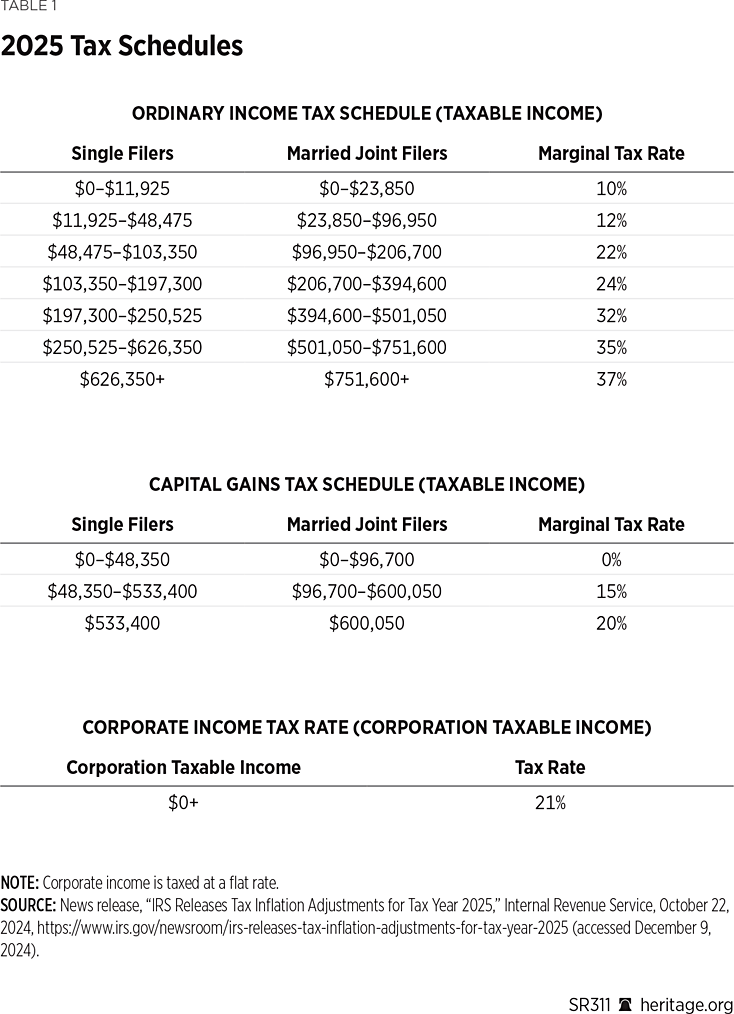
Most qualified capital income is taxed at either 15 percent or 20 percent, with an additional 3.8 percent surtax (the net investment income tax or NIIT) applied on taxpayers with taxable incomes above $200,000 for singles or $250,000 for married joint filers.REF
Corporate taxable income is taxed at a flat federal rate of 21 percent.REF Income that is subject to both the corporate rate and the top qualified capital income tax rate (including NIIT) face a combined federal rate of 39.8 percent.REF
Gross Income, Adjusted Gross Income, and Taxable Income. Most of the income tax code exists, in theory, to allow taxpayers to determine what their taxable income is in any given situation. Taxable income is what is left after all deductions are subtracted from gross (total) income.REF These deductions ensure that businesses are taxed only on the portion of their income that, for tax purposes at least, is considered profits.
For individuals, there is an intermediate concept of income known as adjusted gross income (AGI). AGI is equal to gross income minus any above-the-line deductions.REF Because gross income for individuals includes business-related income, corresponding above-the-line deductions for business expenses are subtracted from gross income to arrive at AGI.REF Other above-the-line deductions include contributions to individual retirement accounts and health savings accounts, alimony payments, certain educator expenses, flexible spending accounts, and student loan interest.REF
The tax code sometimes relies on taxpayers’ AGI to determine, for example, income-based eligibility for various tax credits.
Subtracting below-the-line deductions from AGI then results in taxable income.REF Individuals have two broad choices for below-the-line deductions: the standard deduction or itemized deductions.REF The standard deduction is a flat amount of $15,000 for single taxpayers and married filing separately, $22,500 for heads of household, and $30,000 for married joint filers.REF Taxpayers with itemized deductions exceeding those amounts may claim those deductions instead. As of 2021, the largest itemized deductions were the deduction for charitable giving, the home mortgage deduction, the SALT deduction (currently capped at $10,000 per taxpayer), and deductions for medical and dental expenses.REF
Tax Credits, Deductions, Exclusions, and Exemptions. Tax credits and tax deductions are often confused. Given the choice between a $5,000 tax deduction or a $2,000 tax credit, one might expect that the $5,000 tax deduction would be more beneficial, but the tax credit would be more valuable for taxpayers in every tax bracket.
A tax credit allows a dollar-for-dollar reduction in tax liability, similar to how store credit might reduce dollar for dollar how much an individual is charged at checkout. Some tax credits are refundable, meaning that they can be used to reduce tax liability below zero.REF This results in a tax filer being paid by the government instead of paying taxes. The earned income tax credit is refundable, for example, and the child tax credit is partially refundable.REF In 2025 up to $1,700 of the $2,000 per-child credit can be claimed by taxpayers with no federal income tax liability, subject to an earned income requirement.REF The Obamacare premium tax credit is another refundable tax credit. Individuals may use it to offset some or all (depending on income) of the premiums paid for health coverage purchased through the Obamacare exchanges. Business tax credits are also a major feature of the current tax system, especially since the Inflation Reduction Act of 2022 expanded subsidies related to green energy.REF Altogether, the Joint Committee on Taxation (JCT) estimates that businesses and individuals will claim about $473 billion worth of tax credits in 2025 and about $1.64 trillion in the four-year period 2025–2028.REF
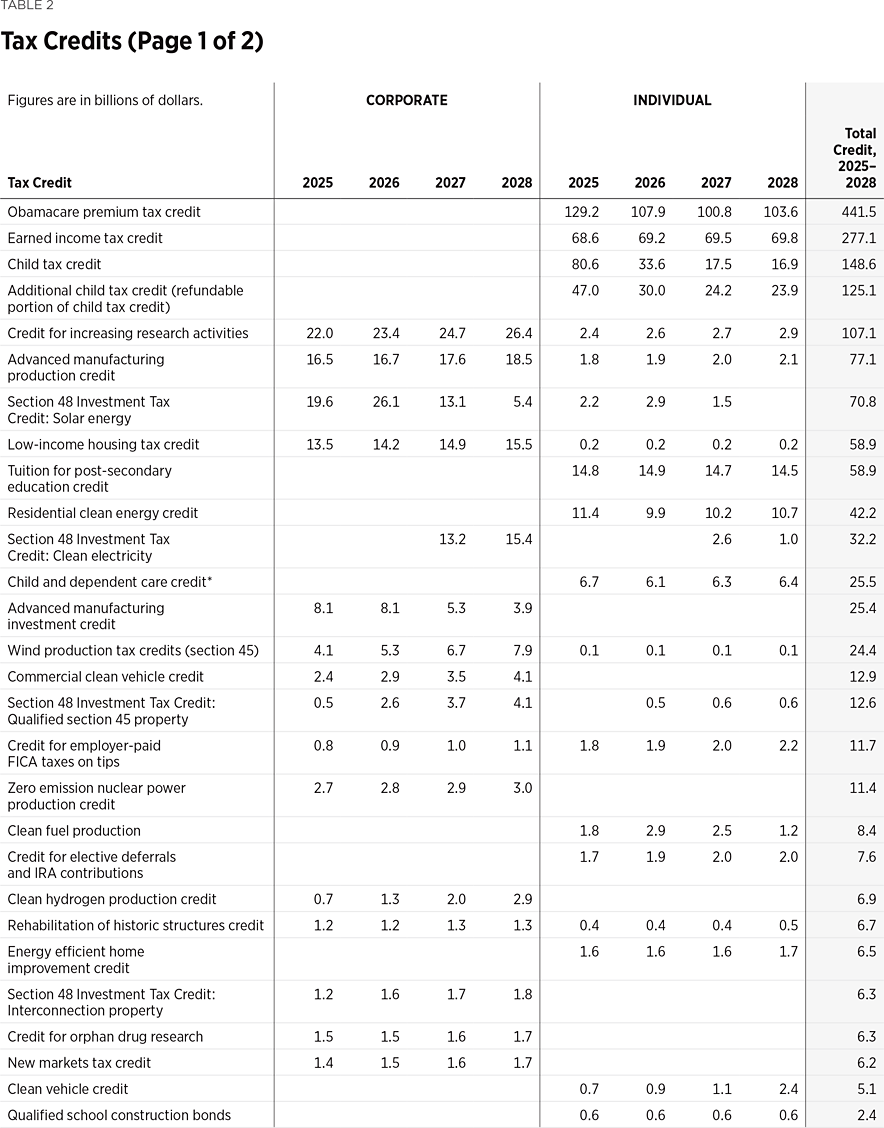
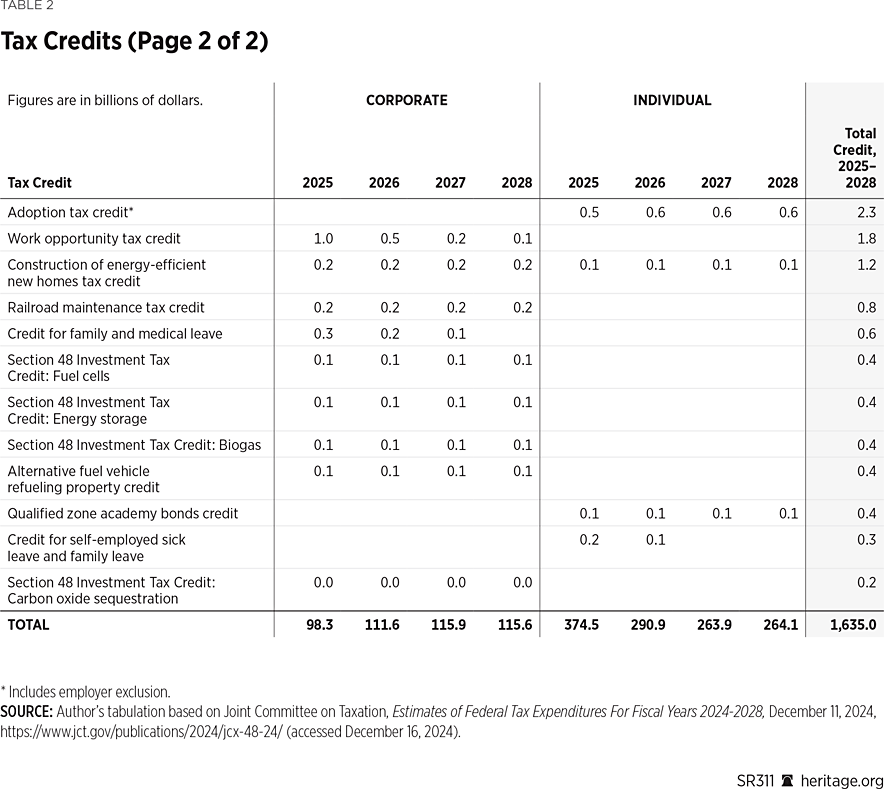
Unlike tax credits, tax deductions are used to calculate taxable income before the applicable tax rate is applied. Therefore, the value of a tax deduction for a taxpayer scales up or down with his or her tax rate. So, for example, a $5,000 tax deduction would potentially reduce the tax liability of a taxpayer in the 22 percent tax bracket by $1,100 (the product of the tax rate and the deduction amount).
Tax Liability = Tax Rate × (Gross Income – Tax Deductions) – Tax Credits
Exclusions refer to untaxed items that are not counted in gross income.REF For example, most non-monetary benefits that individuals receive from their employers, airline and hotel loyalty points, and interest income from municipal bonds are excluded from gross income.REF
Like excluded income, categories or amounts of income that are exempt are also untaxed. The term exemption carries the connotation of a special carveout more than the term exclusion does, but tax exemptions are functionally the same as tax exclusions. There are many examples of both exclusions and exemptions that are (and are not) special carveouts: While the terms exclusion and exemption are largely interchangeable, entities that are not subject to income taxes are generally referred to as tax-exempt.
Exemption amounts or exclusion amounts refer to situations where taxpayers are allowed a certain amount of a type of income before taxes begin to apply.REF For example, U.S. citizens living abroad are subject to U.S. income tax, but the first $130,000 of foreign income is excluded from U.S. income tax as of 2025. The individual alternative minimum tax (AMT) has an exemption amount of $88,100 for single filers and $137,000 for married joint filers. The estate tax (a separate tax from the income tax) has a $13.99 million exemption amount.REF
Gift and Estate Taxes. Property transferred upon death (or through gifts) is potentially subject to the estate or gift tax at a rate of up to 40 percent.REF Property transferred to a surviving spouse is deductible for estate tax purposes.REF Gifts given throughout a taxpayer’s lifetime that exceed the annual gift exclusion amount of $19,000 reduce the $13.99 million estate and gift tax exemption dollar for dollar.REF
Other Features of the Tax System. The income tax system includes at least three minimum taxes, which operate in parallel with the regular tax system: the individual AMT, the corporate AMT, and the base erosion anti-abuse tax (BEAT).REF Taxpayers subject to these minimum taxes must determine whether their taxes would be higher under the regular tax system or under the minimum tax, and they must pay the higher of the two calculated liabilities.
The individual AMT has a 26 percent tax bracket and a 28 percent bracket. These rates apply on a broader tax base that allows fewer deductions and credits than the regular individual income tax does.REF
The corporate AMT (also known as the book minimum tax) is a 15 percent tax on corporations applied to a tax base that roughly approximates their financial statement income (with significant adjustments). The corporate AMT was introduced as part of the 2022 Inflation Reduction Act. The IRS recently released over 600 pages of proposed rules describing how the corporate AMT will operate.REF
The BEAT tax applies to multinational companies with more than $500 million in worldwide gross receipts. The BEAT tax disallows certain deductions related to intercompany payments to foreign subsidiaries and affiliates. The BEAT rate is currently 10 percent (but is scheduled to rise to 12.5 percent if the TCJA expires).REF
Tax Complexity and Compliance Costs. The burden of taxes also includes the time and resources spent in complying with and administering the tax code. Researchers with the Tax Foundation estimated that tax compliance cost Americans 7.9 billion hours of their time in 2024.REF Between time spent by individuals and businesses and out-of-pocket expenses, they estimate that tax compliance costs Americans the equivalent of $546 billion per year. Only 14 U.S. states have a gross domestic product (GDP) that exceeds that amount.REF
What Happens If the Tax Cuts and Jobs Act Expires?
If Congress allows the TCJA to expire, it would result in major changes to individual and business taxes, mostly with the effect of raising taxes and making the tax code more complex. The major changes to the tax system can be categorized as follows:
- General individual income tax provisions
- Alternative or overlapping taxes
- Individual itemized tax deductions
- Business tax deductions
- Other provisions
1. General Individual Income Tax Provisions. Several basic features and parameters of the individual income tax would change if the TCJA expires. Specifically, individual income tax rates would increase, the standard deduction would be reduced by nearly half, personal exemptions would return, and the child tax credit would be reduced from $2,000 to $1,000.
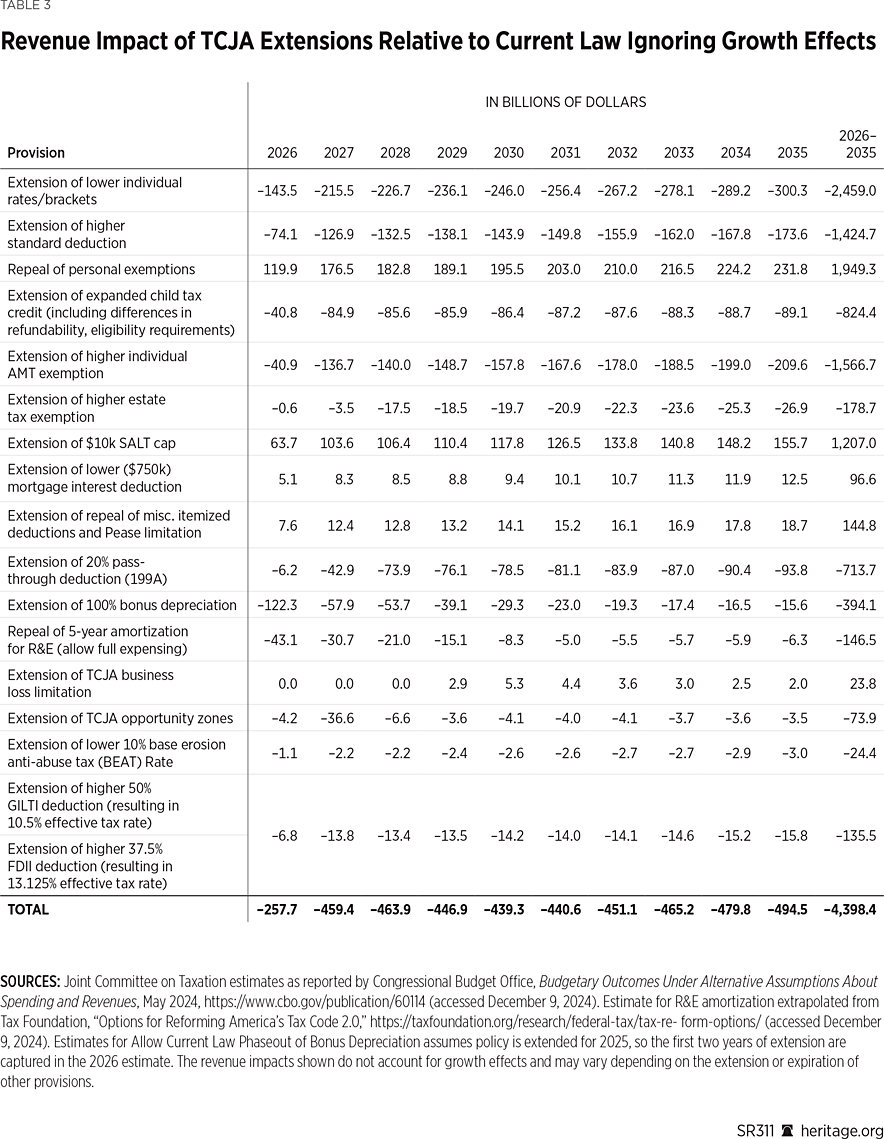
Increased Individual Income Tax Rates. If the TCJA expires, individual income tax rates would rise nearly across the board. The TCJA lowered individual income tax rates and modified the taxable income thresholds that determine taxpayers’ tax brackets, resulting in lower taxes for all income groups.REF These reduced tax rates are scheduled to sunset after 2025.REF
The median individual taxpayer would face a marginal tax rate that is three percentage points higher in 2026 compared to current rates. For example, the top rate would increase from 37 percent to 39.6 percent, the middle (fourth) bracket would increase from 24 percent to 28 percent, and the second-lowest bracket would increase from 12 percent to 15 percent. While the bottom rate of 10 percent would remain unchanged, individuals in that bracket would face significantly higher taxes because of the reduced standard deduction and (in some cases) the reduced child tax credit. (Changes to the standard deduction and child tax credit are discussed below.) No Americans would receive a tax cut from the changes to the rate structure if the TCJA expires.REF
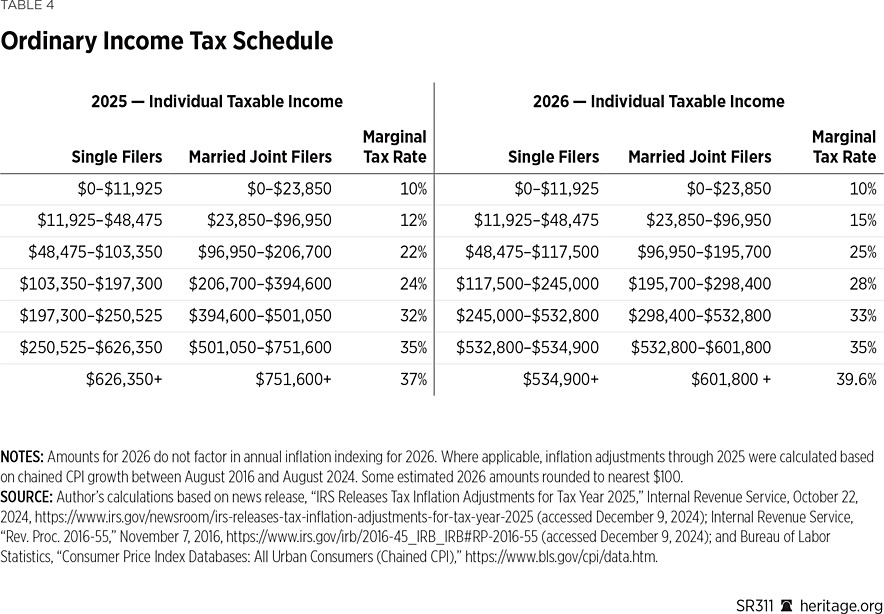
Standard Deduction Reduced by Almost Half. If the TCJA expires, the standard deduction would fall from $15,000 to about $8,100 for single taxpayers. (The deduction is doubled for married joint filers.REF) A $6,900 reduction in the standard deduction would raise the taxes of single filers claiming the deduction by as little as $690 or as much as about $2,730 depending on if they are in the 10 percent bracket, the 39.6 percent bracket, or somewhere in between.REF For married joint filers who do not itemize, losing the standard deduction would be twice as costly within any given tax bracket.
The reduced standard deduction would have no direct impact on the taxes paid by those who itemize their deductions. The small share of Americans who currently itemize are predominantly upper-middle to upper-income Americans. (About 68 percent of itemizers in 2021 had AGIs of $100,000 or more.REF) Itemizing would become more common among middle-income Americans if the TCJA expires.
The TCJA replaced personal exemptions with a higher standard deduction, in part, to simplify tax filing. With a higher standard deduction, fewer taxpayers choose to itemize their deductions. The share of all individual tax returns with itemized deductions fell from 31 percent in 2017 to 9 percent in 2021.REF This shift saved many taxpayers from the hassle of tracking expenses and receipts, decreased the amount of paperwork processed by the IRS, and reduced the potential for audit disputes. If the TCJA expires, taxes would become more complicated and time-consuming for tens of millions of Americans due to the loss of the increased standard deduction.
Return of Personal Exemptions. If Congress allows the TCJA to expire, personal exemptions would return after 2025.REF Personal exemptions would allow taxpayers to deduct roughly $5,200 per qualifying person in the household. Taxpayers would generally be able to claim one exemption each for themselves, their spouses, and their dependents.REF The TCJA eliminated personal exemptions for tax years 2018 through 2025 in favor of the increased standard deduction (described above) and a $1,000 increase in the child tax credit (described below).REF
Each $5,200 personal exemption would reduce taxes by as little as $520 (per person) for taxpayers in the 10 percent bracket and by as much as about $1,450 for some taxpayers in the 28 percent bracket.REF The personal exemption would phase out for higher incomes, meaning that taxpayers in the top three tax brackets would not benefit from it.
Child Tax Credit Reduced from $2,000 to $1,000. The expiration of the TCJA would reduce the child tax credit from $2,000 to $1,000, resulting in a larger tax increase for most parents than for non-parents.REF For low- to middle-income taxpayers facing tax rates below 20 percent, $1,000 of lost child tax credit would result in a larger increase in taxes than the decrease in taxes enabled by the $5,200 personal exemption if the TCJA expires. In addition, if the TCJA expires, more middle- to upper-middle income taxpayers would be subject to the phaseout of the child tax credit. The TCJA lifted the phaseout thresholds from $75,000 and $110,000 of modified AGI for unmarried and married filers to $200,000 and $400,000, respectively. The higher phaseout thresholds are scheduled to sunset after 2025.REF
The refundable portion of the child credit for taxpayers who have zero or negative net income tax liability is commonly referred to as the additional child tax credit (ACTC) to distinguish it from the non-refundable child tax credit amount, which does not reduce tax liabilities below zero. The TCJA expanded the ACTC in addition to the child tax credit. Prior to the TCJA, the ACTC was limited to $1,000 per child and phased in at 15 percent of earned income above $3,000. The TCJA lifted the ACTC cap to $1,400 per child and introduced inflation adjustments that have since increased the ACTC cap to $1,700 as of 2024. Under a permanent extension of the TCJA, the full amount of the child tax credit would eventually be refundable (at $2,000 per child) as only the refundable ACTC amount is inflation adjusted. The TCJA also lowered the start of the ACTC phase-in from $3,000 to $2,500 of earned income.REF
If Congress allows TCJA to expire after 2025, the ACTC would revert to the less generous pre-TCJA parameters. The expiration of TCJA would also eliminate the requirement that a taxpayer claiming the child tax credit or ACTC provide the child’s Social Security number—a policy meant to limit fraudulent payments and benefits going to illegal immigrants.REF This requirement in the TCJA did not apply to the adult relatives who claim the children for purposes of the child credit. Therefore, even under the TCJA, illegal immigrant adults who have children, stepchildren, nephews, nieces, or grandchildren (for example) who are U.S. citizens may still claim the child tax credit in some cases.
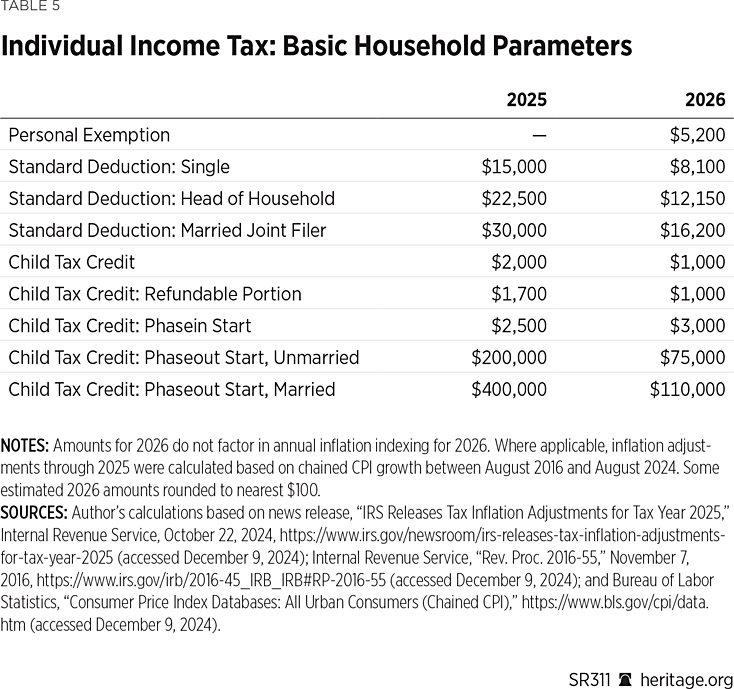
2. Changes to Alternative or Overlapping Taxes. Two of the significant expiring provisions involve changes to tax structures that lie outside the standard individual and corporate income tax systems. Specifically, should the TCJA expire, the exemptions for the individual AMT and the estate and gift taxes would be reduced, resulting in more individuals becoming subject to these taxes.
Expansion of the Alternative Minimum Tax. An often-overlooked expiring provision in the TCJA is the increase in the individual AMT exemption, which was an important simplifying tax cut. If Congress allows the TCJA’s changes to expire, the AMT exemption would fall by about $19,000 for unmarried filers and by about $29,000 for married filers. The AMT exemption would also begin phasing out at about $154,300 for unmarried filers and $205,700 for married filers, as opposed to the current phaseouts of $626,350 and $1,252,700, respectively. The TCJA’s changes to the AMT exemption and phaseouts are scheduled to sunset after 2025.REF
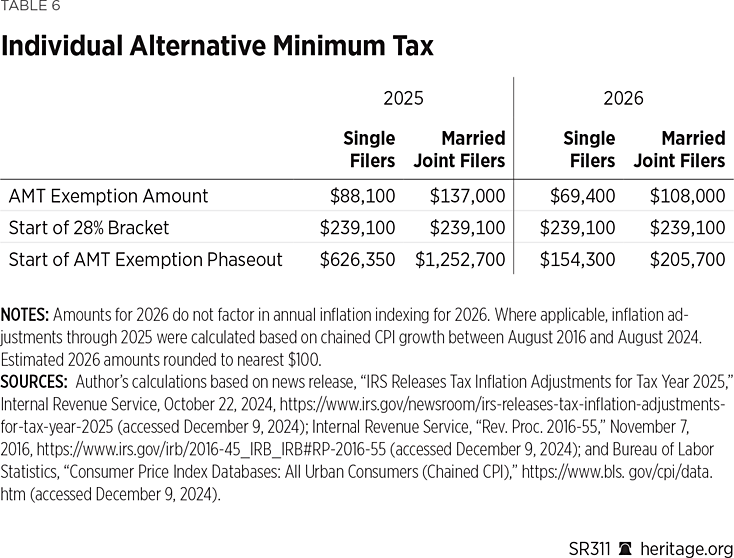
Before the TCJA, the number of Americans who were subject to the AMT was steadily increasing, rising from 3.94 million in 2013 to 5.08 million in 2017.REF Even more Americans were required to determine whether their AMT liability exceeded their ordinary tax liability. In the four years following the passage of the TCJA, the number of Americans paying individual AMT taxes dropped by 96 percent to about 200,000.REF
The expiration of the TCJA’s reforms would expand the number of Americans subject to AMT taxes by about 7 million people so that in 2026 Americans would file an estimated 7.2 million tax returns with AMT tax liability.REF
Expansion of the Estate and Gift Taxes. If the TCJA expires, the estate and gift tax exemption amount would be halved in 2026. The TCJA temporarily doubled the estate and gift tax exemptions, allowing a total of $11.18 million (in 2018) in lifetime gifts or transfers upon death to be untaxed before the estate and gift taxes take effect.REF The exemption amount is adjusted for inflation and stands at $13.99 million as of 2025.REF The top estate tax rate is 40 percent and was unchanged by the TCJA.REF The higher tax exemption amount is scheduled to expire after 2025, but the estate tax rates would remain unchanged.
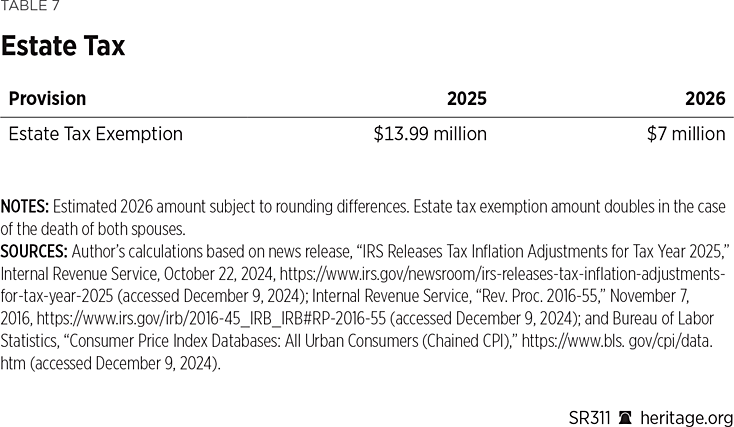
Despite the steep 40 percent tax rate, estate and gift tax revenues represent a comparatively small revenue source (averaging about 0.6 percent of federal revenues in the past decade).REF Following the TCJA, estate and gift tax revenues did not fall as dramatically as some expected. The JCT estimated that the 2018–2025 increase in the estate and gift tax exemption would reduce overall tax receipts by a total of $83 billion compared to if the TCJA had not been enacted.REF In fact, while estate and gift tax collections fell by about $6 billion each in the 2019 and 2020 fiscal years relative to 2017 and 2018, 2023 estate and gift tax collections were up by about $11 billion compared to 2017.REF
Although the estate tax represents a minor revenue source for the United States, it can have severe ramifications for family farms and family businesses. Owners of family farms, in particular, are often “asset rich but cash poor,” so the family members who inherit them are often unable to raise the funds needed to pay the estate tax unless they sell off the inherited property.
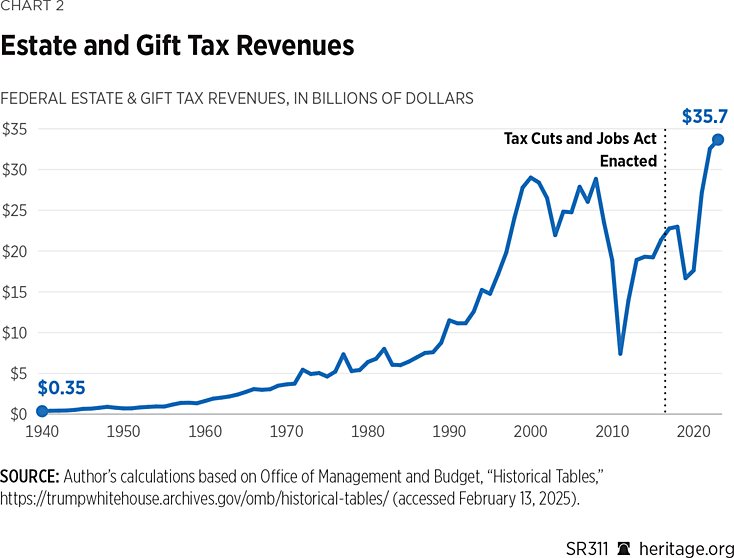
3. Changes to Itemized Deductions for Individuals. The TCJA encouraged individuals to take the standard deduction instead of itemized deductions both by making the standard deduction more generous and by limiting the generosity of itemized deductions. If the TCJA expires, individuals would regain the more generous itemized deductions through the elimination of the cap on the SALT deduction, a higher home mortgage interest deduction, and the return of various miscellaneous itemized deductions.
Return of an Uncapped State and Local Tax (SALT) Deduction. If the TCJA expires, the $10,000 cap on the SALT deduction would be eliminated, and the deduction would revert to being uncapped as it was through 2017.REF Taxpayers would again be able to deduct all state and local income and property taxes paid or, alternatively, to deduct all state and local sales and property taxes.REF
The $10,000 SALT deduction cap was the TCJA’s largest revenue-raising provision.REF Prior to the implementation of the TCJA, Americans claimed more in SALT deductions than any other itemized deduction. In 2017, the last tax year before the TCJA, Americans claimed about $625 billion in individual SALT deductions. After the TCJA, that figure plummeted. In the most recent year with data (2021), Americans claimed only about $120 billion in SALT deductions.REF (See Table 9.) The SALT cap broadened the tax base, enabling significant reductions in tax rates.
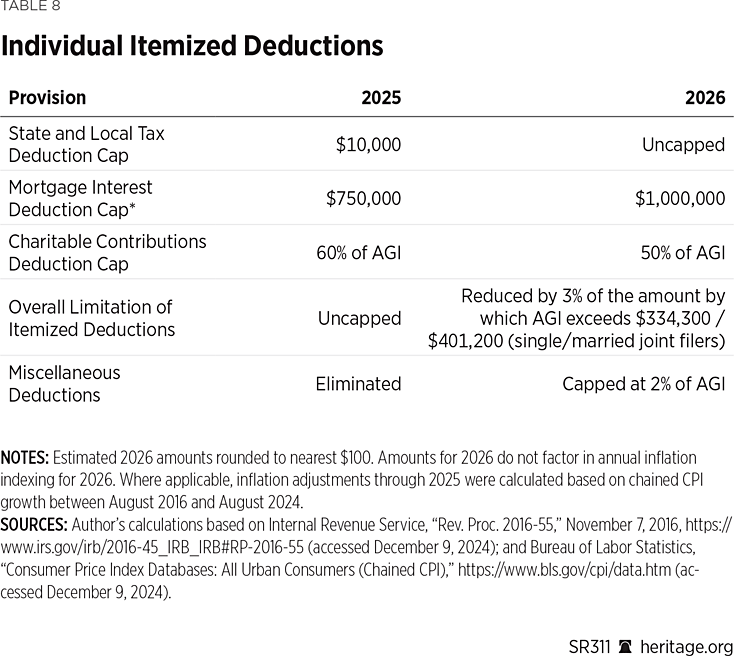
The elimination of the SALT cap would reduce taxes most for high-income taxpayers, especially those from high-tax states such as New York, California, and New Jersey, who are more likely to exceed the SALT cap.REF It would not reduce taxes for those who claim (or would claim) the standard deduction.
Critics argue that when states raise taxes, the SALT deduction effectively shifts some of the federal tax burden away from the residents of the state raising its taxes, increasing the burden on residents of other states. By shifting the tax burden from high- to low-tax states, the SALT deduction incentivizes growth of state and local government taxes and spending.REF
The SALT deduction also favors state and local reliance on income taxes and property taxes over state sales taxes. Sales taxes can be deducted only in lieu of income tax deductions. (Typically, income tax payments are higher, and they are easier to track.REF) In 2017, only 3.3 percent of the amount of SALT deductions claimed was for sales taxes paid.REF (See Table 9.)
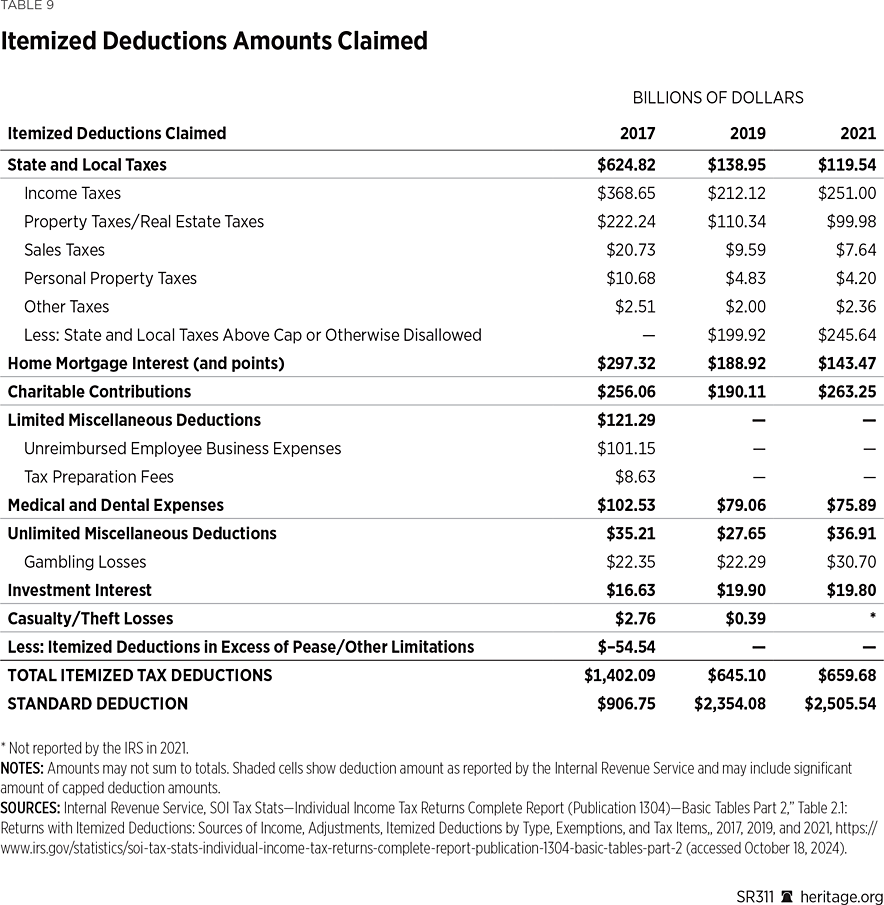
Expansion of the Mortgage Interest Deduction. If the TCJA expires, the limitation on the mortgage interest deduction would revert to $1 million in mortgage debt on which interest payments are deductible.REF The TCJA tightened the limit on the home mortgage interest deduction, temporarily reducing it to $750,000 of mortgage debt eligible for the deduction.REF
Prior to the implementation of the TCJA, the mortgage interest deduction was the second-most used itemized deduction, behind only SALT. In 2017, Americans claimed about $297 billion in mortgage interest deductions. In the most recent year with data (2021), Americans claimed less than half that amount at $143 billion.REF
The lower limitation on mortgage interest deductions in the TCJA helped broaden the tax base, making lower tax rates possible. However, an economic case can be made for allowing an uncapped mortgage interest deduction on neutrality grounds. Interest expenses deducted by borrowers balance out the taxable interest income of the mortgage lender. If the borrower and lender face the same tax rates, then taxes on interest income and a full deduction on interest expenses would offset, which makes economic sense. A loan does not generate more income for the two parties to spend—it only shifts the timing of when each party can spend. Therefore, taxing interest income without allowing a corresponding deduction for interest expenses introduces a bias against lending and borrowing.REF
Congress could alternatively ensure neutral treatment of interest by reforming the tax system so that interest income is not taxable and interest expenditures are not deductible. Such a system would ensure that differences in tax rates and the treatment of interest would not drive borrowing and lending decisions.REF Such simplifying reforms could make sense as part of a comprehensive overhaul of the tax system.REF Piecemeal changes, such as the cap on the mortgage interest deduction, fall short of that ideal.
Return of Itemization of Deductions and the Pease Limitation. If the TCJA expires, more than 40 million more American taxpayers are expected to itemize their deduction than do today.REF These new itemizers would no longer benefit from the simplification of using the standard deduction.
Various miscellaneous itemized deductions would return if the TCJA sunsets, including deductions for unreimbursed work expenses, tax preparation fees, subscriptions to professional journals, union dues, and dues for professional societies.REF These deductions would be allowed only to the extent that the deductions exceed 2 percent of AGI. These miscellaneous deductions would be restored alongside the more generous deductions allowed for SALT and mortgage interest described above.
The expiration of the TCJA would also bring back the Pease limitation for high-income earners. The Pease limitation, named after former Ohio Congressman Donald Pease (D), is a relic from the 1990 tax hike bill that contributed to President George H. W. Bush’s defeat in his 1992 reelection bid. Under the Pease limitation, itemizers with AGI above $334,300 (for single filers) and $401,200 (for married joint filers) would face a special limitation on their itemized deductions.REF For every $100 of AGI above the respective income thresholds, the Pease limitation would reduce itemized deductions by $3. The Pease limitation would reduce taxpayers’ itemized deductions by up to 80 percent but no further. For example, under the Pease limitation a single, high-income taxpayer with $100,000 of itemized deductions might be limited to a $20,000 deduction.REF
4. Changes to Business Deductions. The TCJA made several changes to business tax deductions, including adding a new deduction for individuals with pass-through business income and changes affecting the timing of business deductions. The TCJA temporarily replaced the system of depreciation schedules of up to 20 years and instead allowed businesses to fully deduct the cost of equipment and machinery in the tax year that the assets are purchased and put in use. The law also required five-year amortization of research and experimental (R&E) expenditures and placed an annual limitation on how much non-business income individuals could offset with business losses in a given year. Many of the TCJA’s changes to business deductions are set to expire or are currently phasing out.
Expiration of the Pass-Through Deduction. The 20 percent pass-through deduction is scheduled to sunset after 2025. This deduction—also known as the Section 199A deduction or the qualified business deduction—allows sole proprietors and individuals with pass-through business income to deduct 20 percent of qualifying business income.REF The deduction effectively reduces the bottom individual tax bracket for qualifying small businesses from 10 percent to 8 percent and the top individual tax bracket from 37 percent to 29.6 percent.
The pass-through deduction does not apply to all business income of individuals. Some restrictions and limitations apply:
- Specified services trade and businesses—such as businesses engaged in health services, law, accounting, actuarial science, performing arts, consulting, athletics, financial services, and brokerage services—face a pass-through deduction phaseout if individual taxable income exceeds $197,300 ($394,600 for married joint filers).REF
- The pass-through deduction is limited to the greater of 50 percent of the company’s W-2 wages related to the business or 25 percent of W-2 wages plus 2.5 percent of unadjusted basis in qualifying business property.REF
The TCJA included the pass-through deduction for owners of businesses that are perceived as being small or midsize to balance out the TCJA’s reduction in the corporate rate.REF (Although some large companies are organized as pass-through entities, most are structured as C corporations because of the S corporation 100 shareholder rule.REF)
While the corporate rate is lower than the current top effective pass-through tax rate, it is inaccurate to say the corporate rate is preferential. Corporate income is also subject to an extra layer of tax at a 15 percent to 23.8 percent rate at the investor level when profits are ultimately distributed to the shareholders or when corporate stock is sold.REF
If the TCJA expires outright, sole proprietors and pass-through businesses in the top tax bracket could be at a competitive disadvantage compared to corporations. The top pass-through tax rate of 39.6 percent would be similar to the combined corporate and long-term capital gains rate, but owners of pass-throughs have to pay their full tax rate up-front on all earnings, including earnings retained by the businesses. In contrast, corporate shareholders can defer investor-level taxes on earnings retained by the corporations, only paying taxes when they ultimately realize income from their investments (e.g., through dividends or stock sales).REF
The expiration of the pass-through deduction would make organizing as a pass-through business less attractive than it is now. Some businesses would respond by reorganizing as C corporations.
Phaseout of Full and Immediate Expensing for Machinery and Equipment. A key TCJA business provision—full and immediate expensing for machinery, equipment, and other assets with useful lives of up to 20 years—has been winding down since January 2023.REF The provision, also called “bonus depreciation,” allowed businesses in 2018–2022 to deduct 100 percent of the value of qualifying capital assets in the year those assets were placed in service instead of following the IRS’s complex rules for depreciation of various asset classes.REF
Under current law, the bonus depreciation percentage is scheduled to decrease by 20 percent per year in 2023–2026. Assuming no extension of the TCJA, a company would be allowed to fully and immediately expense 40 percent of the basis of a qualifying asset purchased in 2025, while the remaining 60 percent of the asset would be subject to regular depreciation over up to 20 years (depending on the tax code classification of the asset in question).
Typically, businesses can deduct legitimate expenses as they are incurred, but depreciable assets, which are deducted over time, are the notable exception. By allowing full and immediate expensing for most capital assets, the TCJA (temporarily) shifted the business tax system closer to a cash flow tax system.REF Under a cash flow tax system, a company’s taxable income base in each period is the difference between business revenues and business expenses.REF Such a system is simpler than one that requires capitalization of some expenses, and it has the advantage of neutrality by treating purchases of equipment and machinery the same as expenditures on supplies, utilities, or marketing. Neutrality helps ensure that companies’ budget and cash flow decisions are driven by market forces, not by uneven tax treatment.
The punitive nature of long depreciation schedules for physical capital investments is especially harmful to capital-intensive industries such as manufacturing, construction, mining, and oil extraction. This unfavorable tax treatment reduces investment and inhibits the productivity and wages of workers in affected industries.
The TCJA did not (temporarily or permanently) change the depreciation schedules for certain longer-lived assets such as non-residential structures and residential rental structures, which retained depreciation schedules of 39 years and 27.5 years, respectively.
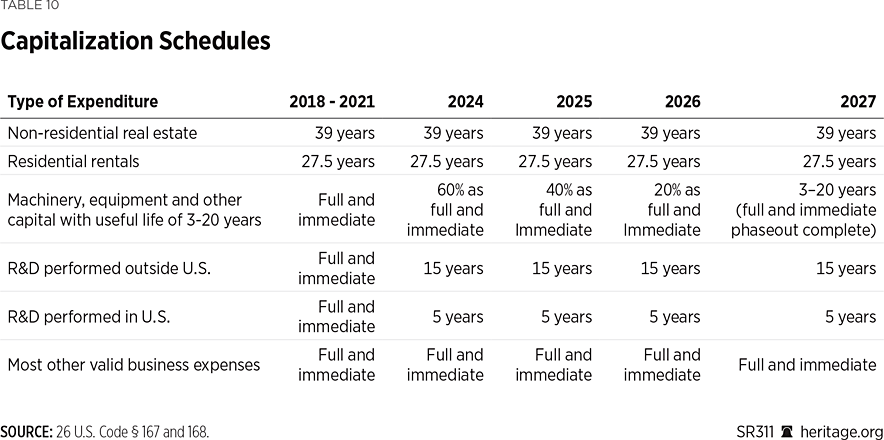
Permanence for Amortization of Research Expenses. The TCJA made R&E expenditures subject to five-year amortization schedules beginning in 2022.REF Before the TCJA, taxpayers could fully and immediately deduct R&E costs. Amortization, like depreciation, involves the capitalization of business expenditures—but specifically expenditures involved in creating intangible assets.
Although the TCJA made R&E amortization permanent, many lawmakers and outside observers hoped it would never take effect. R&E amortization was included in the tax bill to help ensure the legislation remained within reconciliation budget constraints, but there is no sound economic basis for discouraging companies from engaging in research by denying them full and immediate expensing for those expenditures.REF
R&E amortization follows a straight-line method, so deductions for R&E expenditures are spread out evenly across a five-year period. It uses the midpoint convention, so the five-year period starts six months into the year.REF Therefore, a $100 R&E expenditure in year 1 results in a deduction of $10 in the first tax year, $20 in each of years two through five, and $10 in year six.
The increase in interest rates in recent years has made the delay in deductions related to amortization and depreciation more economically damaging. To the extent that companies borrow to cover an accelerated tax liability, the cost of doing so is on the rise.
Although not technically a TCJA expiration, Congress could use the occasion of the TCJA’s expiration to restore full and immediate expensing for R&E.
Expiration of Business Loss Limitations. If the TCJA expires, the current annual limitation on business losses that can be deducted on personal taxes would expire. In 2018, individuals, estates, and trusts were limited to using $250,000 of business losses ($500,000 for married joint filers) to offset income from other sources.REF With inflation adjustments, those limits now stand at $313,000 and $626,000.REF Individuals can carry forward any disallowed losses indefinitely to future tax years as net operating losses.
The annual cap on deductible business losses is scheduled to expire after 2025. However, some pre-existing limitations on passive business losses will continue to apply.REF
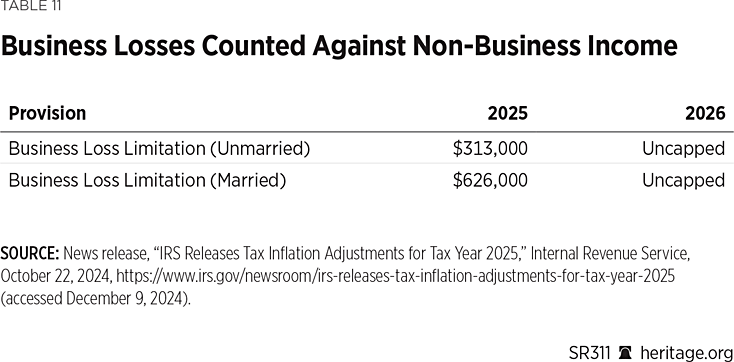
5. Other Changes. The TCJA established opportunity zones to incentivize business investments within low-income areas in each state. The TCJA tax advantages for opportunity zones are scheduled to expire in stages. The TCJA also reformed the international business tax code, transitioning toward a territorial tax system, where U.S. multinational companies owe U.S. taxes on foreign operations only in limited circumstances—and at a lower rate (excluding foreign taxes) than the domestic corporate tax rate. If the TCJA’s changes take effect as scheduled, international income will be taxed at higher effective rates starting in 2026.
Expiration of Opportunity Zones. The TCJA created place-based tax breaks for businesses making investments within “opportunity zones.”REF Under the law, state governors nominated low-income census tracts within their states—limited to no more than 25 percent of the state’s low-income census tracts plus a small number of neighboring census tracts—for certification by the Secretary of Treasury as qualified opportunity zones.REF The list of approved opportunity zone designations was finalized in mid-2018.REF
Depending on the length of investment and other factors, qualifying opportunity zone fund investments can qualify for temporary deferral on capital gains income or a partial or full exclusion of capital gains income related to the investments.REF Deferred gains must be recognized by December 31, 2026. The designation of census tracts as opportunity zones lasts for 10 years and expires in 2028. However, qualifying opportunity zone funds may appreciate free of capital gains through 2047, even after the lapse of the opportunity zone designation.REF
Tax Hikes on Companies with International Operations. Before the TCJA, the United States was one of the few developed countries to impose a worldwide corporate tax, meaning that U.S. multinationals with foreign operations paid U.S. taxes on both domestic and foreign income.REF The TCJA established a hybrid international system, shifting toward a territorial tax system in which American companies are taxed only on their income earned in the United States.REF However, under the TCJA, foreign corporate income is subject to U.S. taxation in certain limited circumstances. If scheduled TCJA changes occur after 2025, companies would face three separate tax hikes related to these hybrid portions of the international tax code.
First, under current law, the base erosion anti-abuse tax (BEAT) rate is set to increase from 10 percent to 12.5 percent after 2025.REF BEAT is a tax on certain intercompany payments—known as base erosion payments—made from U.S. companies to their foreign subsidiaries and other affiliates. Companies with more than $500 million in worldwide gross receipts and base erosion payments exceeding a threshold roughly equal to 3 percent of total deductions may be liable for the tax.REF Applicable companies must calculate “modified taxable income,” a concept similar to regular taxable income but without allowance of any deductions claimed for base erosion payments.REF The base erosion payments that are disregarded when determining modified taxable income include many intercompany payments.REF Some specified types of payments are not considered base erosion payments, including, for example, the cost of goods sold and payments for certain low-margin services such as payroll, accounts receivable, general administrative, accounting, staffing and recruiting, general legal services, and information technology.REF If the company’s calculated taxes from the BEAT rate applied to the modified taxable income base are higher than its taxes as calculated using its regular tax base, the company must pay the difference in a “base erosion minimum tax payment.”
Second, the U.S. effective tax rate on GILTI is scheduled to rise from 10.5 percent to 13.125 percent.REF While the name (short for global intangible low-taxed income) suggests that GILTI relates only to income derived from holding intellectual property abroad, the provision does not explicitly distinguish how controlled foreign corporations (CFCs) earn income, such as from royalties versus the sale of goods and services. Instead, U.S. companies owe GILTI taxes when their CFCs earn high returns on assets while paying low foreign tax rates on that income.REF If a U.S. company’s CFCs earn above a 10 percent return on qualified assets less interest expenses, the company is potentially subject to GILTI taxes on the “excess” return. For 2018–2025, the TCJA allowed U.S. corporations to deduct 50 percent of their GILTI income, so instead of a 21 percent corporate rate, they effectively paid up to a 10.5 percent tax rate on GILTI before factoring in foreign tax credits. The GILTI deduction will fall from 50 percent to 37.5 percent after 2025, leading to an effective minimum rate of 13.125 percent.REF Companies can use only 80 percent of foreign tax credits to offset GILTI, though, so some GILTI tax may apply to companies if the average foreign tax rate on their CFC income is below 16.406 percent.REF
Third, if the taxation of GILTI was intended to discourage U.S. companies from putting highly profitable operations overseas, the foreign-derived intangible income (FDII) provision in the TCJA was intended to encourage multinationals to keep valuable intellectual property in the United States and to perform very profitable activities here. FDII allows a deduction that effectively reduces the tax rate on income earned by U.S. companies on foreign sales to the extent they earn above a 10 percent return on qualified assets. The deduction is currently 37.5 percent, resulting in an effective tax rate on FDII of 13.125 percent. The FDII deduction is set to fall to 21.875 percent after 2025, meaning an effective tax rate of 16.406 percent.REF
Early iterations of the TCJA did not include BEAT, GILTI, or FDII. Instead, lawmakers in 2017 originally proposed replacing the worldwide business tax system with a border adjustment mechanism,REF which would make business taxes fully territorial. Under such a system, products made internationally and sold in the United States would be included in the U.S. tax base, but products made in the United States and sold abroad would be taken out of the U.S. tax base.REF Border adjustments are an inherent feature of the value added taxes that most other countries around the world use. Similarly, the sales taxes that most states impose apply on goods and services consumed within the state but exempt products made in the state but sold and consumed elsewhere.
Taxes and America’s Fiscal Position
The United States’s $36.2 trillion national debt presents a major challenge for lawmakers. Even this large number significantly understates the size of America’s fiscal hole. If unfunded obligations such as Social Security and Medicare are included, the actual size of the fiscal hole is roughly $107 trillion.REF However, the soaring national debt stems from overspending, not a lack of federal tax collections. In the second half of the 1920s, federal government spending was only about 3 percent of the economy.REF Today, federal outlays account for about eight times as large of a share of the economy.REF
Federal spending soared during the Great Depression and World War II and remained high after the war ended. Other than a period of relative spending restraint in the 1980s and 1990s, federal outlays have steadily grown as a share of the economy since the late 1940s. Federal outlays rose from about 14 percent of the economy in 1947 to an estimated 24.6 percent in 2024.REF
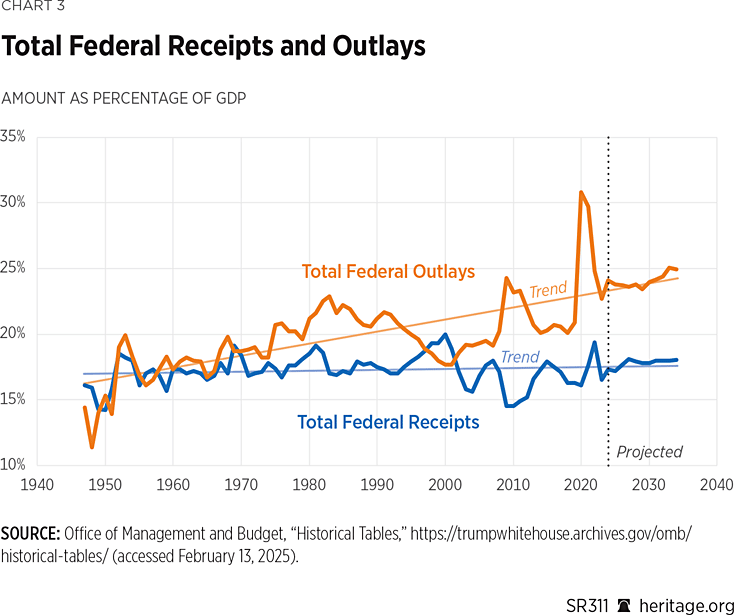
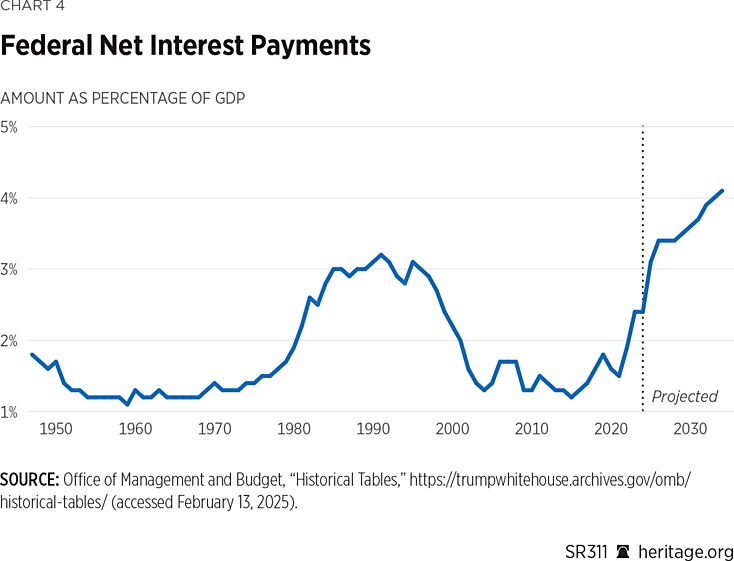
Although taxes as a share of the economy have remained at historically high levels for the past 80 years, they have not kept up with the growth of government spending.REF Since 1947, total federal receipts have averaged about 17 percent of GDP, staying consistently in a range between about 15 percent and 20 percent.REF Because of soaring spending, the national debt has nearly quadrupled since the start of the 2008 financial crisis and has grown by $13 trillion since the start of the COVID-19 pandemic in 2020.REF
The Congressional Budget Office (CBO) projects that federal receipts as a share of GDP will remain slightly above the 80-year historical average over the course of the next decade through 2034 and will trend higher in the following decades, reaching 18.8 percent by 2054.REF
While tax revenues are expected to increase slightly, spending is expected to soar. The CBO’s 30-year projections show federal outlays hitting 27.3 percent of GDP by 2054, suggesting the government will spend roughly $3 for every $2 it receives. Because of the widening gap between outlays and revenues, the national debt is expected to continue to grow at an accelerating pace. The CBO forecasts that, by 2054, the debt-to-GDP ratio will be 166 percent—higher than almost any other modern country.REF The CBO projects that federal net interest payments alone will account for 6.3 percent of GDP and 23 percent of federal outlays, making it the largest line item in the federal budget (including Social Security).REF
Worryingly, the CBO’s forecasts of debt and interest payments are almost certainly too optimistic. They assume that interest rates will remain low by historical standards, with an average interest rate on federal debt of just 3.8 percent in 2054.REF If interest rates climb, it could set off a vicious cycle of increasing outlays to service the debt, more rapid debt accumulation, decreasing confidence in U.S. debt and the dollar, and further increases in interest rates. Such a cycle would put downward pressure on economic growth (which the CBO may also be too optimistic about unless government spending is put in check) and would further exacerbate the debt crisis.
Recommendations
The goal of this report is not to advance a specific package of provisions that should be included in a TCJA extension bill in 2025. Instead, the purpose is to help shorten the learning curve for policymakers involved in the debate over TCJA extensions, equipping them to make well-informed decisions. Nevertheless, this report offers the following general recommendations.
Congress should:
- Be realistic about trade-offs. Every dollar the federal government spends imposes a cost on taxpayers whether through higher taxes, more debt (future taxes), or heightened inflation if the Federal Reserve monetizes the debt. Tax cuts do not entail a “cost” to the government; rather, they eliminate a cost on taxpayers. In 2025, Congress will have to decide how to prioritize each of the 15 provisions described above, as well as any other potential tax cuts it may want to consider. Spending cuts and base-broadening reforms—such as the elimination of narrow tax exemptions and credits—would facilitate more tax-cutting reforms. Trade-offs on taxes will become increasingly severe over time if the federal government stays on its current unsustainable fiscal path.
- Take the debt seriously. The national debt is a major problem, and the expected trajectory of the national debt could ultimately prove catastrophic if it is not addressed. Growing deficits can exacerbate inflation, especially if the nation’s creditors lose confidence in the government’s ability to make debt service payments and stop buying U.S. debt. Congress should recognize that reckless growth of the national debt threatens America’s future prosperity and security, but it should also recognize that the national debt exists because Congress spends too much, not because it taxes too little.REF
- Pair tax cuts with spending cuts and regulatory reforms. Whether through budget reconciliation or outside of budget reconciliation, it is imperative that Congress cut spending to ensure that the economic gains from tax cuts are not swamped by the harmful effects of government spending and deficits. Reducing regulations is also critical to promote economic growth. Under the Congressional Budget Act, changes to discretionary appropriations cannot be made through the budget reconciliation process. However, cuts to mandatory or “autopilot” spending are allowable under budget reconciliation. In 2024, 73 percent of the federal budget was on autopilot.REF Pairing tax cuts with reduced mandatory spending would instill confidence in taxpayers and global markets that the tax cuts are sustainable. Additionally, Congress should pass regulatory reforms—such as administrative pay as you go (PAYGO) and the Regulations from the Executive in Need of Scrutiny (REINS) Act—to foster economic growth and improve the long-term viability of tax cuts.
- Reject a short-term TCJA extension. Some in Congress may be tempted to avoid making long-term decisions about the tax code. They should resist that temptation. A short-term extension of the TCJA would be scored as having a smaller deficit impact, but it would do so merely by pushing the difficult work and decision-making to the next Congress. This would be a bad precedent to set, enabling future Congresses to justify continuing the pattern of short-term extensions without long-term resolution to the tax code or to America’s spending problem. This would leave the American economy in limbo, with businesses and individuals perpetually unsure of what the tax code might look like in the coming years. Instead, Congress should strive to bring resolution to the existing uncertainty in the tax code during the time they have in Washington.
Conclusion
President Trump and the new Congress face major challenges, and the looming TCJA expirations are at the forefront. If the TCJA expires outright, it would represent the largest U.S. tax hike in generations. The economic consequences could be severe.
Thin Republican majorities, particularly in the House, mean that it will be critical for conservatives to reach consensus or compromise about the right path forward. A strong understanding of what is at stake and the many contours of the tax system and the expiring tax provisions can help enable lawmakers to arrive at the most well-thought-out tax package possible. Americans will rely on lawmakers to step up and act in the best interest of the taxpayers they represent to stave off both unnecessary economic pain and fiscal calamity.
Preston A. Brashers is Research Fellow for Tax Policy in the Grover M. Hermann Center for the Federal Budget at The Heritage Foundation.



